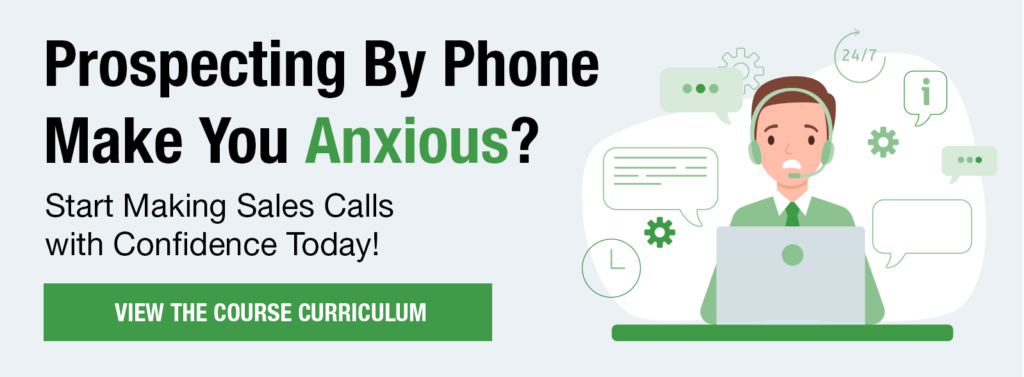Outbound Prospecting: How to Identify Prospects that Buy in a Down Market

Outbound Prospecting:
How to Identify Prospects that Buy in a Down Market
The word “Prospecting” used to send chills down my spine. I hated it with a passion.
Using the phone to make outbound prospecting calls to random companies to hear “no, thanks, not interested, we’re all set” is a sure-fire way to skyrocket call reluctance and increase burnout.
Before you know it, the phone feels like a 25lbs weight, and you don’t want to pick it up anymore.
Most salespeople won’t have to prospect much when there’s plenty of low-hanging fruit, but when, for whatever reason, it’s time to climb, you better know how to pick what’s ripe.
Right now, companies are having to make more outbound calls than ever before because the “easy sales” are no longer hanging around. You can increase your output all you want, but if you’re barking up the wrong tree, at the end of the day, you will have exhausted a lot of effort and have minimal results to show for it.
In a minute, I’ll show you five (5) steps to help you build a pre-qualified list of prospects that you’ll have a better chance of closing, no matter what the economy is doing.
Outbound Prospecting: Your ICP (Ideal Customer Profile)
If you are in sales, you should know what your ICP is. No exception. 100% of you reading this should know who your target audience is.
However, I am shocked that about 90% of the sales reps (SDRs, BDRs, ISRs, and AEs) have no clue who their real target audience is. They often think it’s “everyone.” So, their outbound prospecting efforts include blasting out emails or making phone calls that net very little return.
FOMO Prospecting
FOMO (Fear of Missing Out) Prospecting is when a sales rep goes after anyone and everyone within their market. I understand the allure. You want every sale you can get.
The problem with prospecting this way is this:
You’re looking for a needle in a haystack. Why not shrink the pile and focus on where the best needles are?
When it comes to outbound prospecting, you want to go “deep” not “wide.”
When the leads are flowing in, and you get a hot prospect that is just outside your standard ICP, fine.
But when the inbound lead spigot is down to a drip, and you have to pick up the phone to make outbound calls, your best bet is to focus on those whom you have the highest chances of converting.
Here’s how to identify who those prospects are.
Outbound Prospecting: How to Identify
The best place to look is your past clients.
Here’s a simple solution I use to identify who my targeted audience is:
- In Salesforce, create a report based on deals your company has won over the past two fiscal years.
- The report should have the following data on each deal. Have the report only pull deals that are in the price range of the size of transactions you are truly after. IMPORTANT: Forget the one-off super large deals and do not include the small, low-profit deals. We are not whale hunting here (unless that is your actual target), nor are we looking to have data from small, low-profit sales. Remember, you are doing outbound prospecting. Chances are, you want deals that will close in a reasonably decent time frame as well as be worth the chase.
- Location: Country or State, depending on your business model.
- Employee Size
- Annual Revenue
- Industry
- Run the report: once you have created your report with the filters mentioned above, run the report and export the results to Excel.
- Analyze: Here’s the breakdown of what I found when I did this for my own company:
- Companies with 10 to 50 employees accounted for 24% of my business.
- Companies with 50 to 500 employees accounted for 47% of my business!
- Companies with 500 to 1000 employees accounted for 12% of my business.
- Companies with 1000 to 5000 employees accounted for 6% of my business.
- Companies with 5000 to 10000 employees accounted for 6% of my business.
- Companies with 10,000+ employees accounted for 5% of my business.
Clearly, the companies with anywhere from 50 to 500 employees are the ones my outbound prospecting efforts need to be focused on as I have a 2-to-1 advantage over my next closest win category.
Your highest win category is where to focus when doing outbound prospecting because that is the niche that you will have the most success with when it comes to helping them solve a problem and getting the ROI you are after with your prospecting efforts.
It’s a win/win for all parties involved.
5. Build a Lead List: In Salesforce (or whatever CRM you are using), build a lead list that matches the criteria of your top prospects, and get to work.
Outbound Prospecting: Data Sources
Some companies will already have the demographic data on all their leads in their CRM. Others won’t. If you’re in the last category, here are some resources for you to look into for your use.
I use to use Datanyze to auto append all my leads. I LOVED the product; however, their ZOOMInfo merge caused them to “zoom” their prices to the moon and make it unaffordable for most small businesses. But if you’re an enterprise-level company, I would be shocked if you’re not using them already.
I’ve also heard good things about Clearbit – however, their pricing is also on the top end.
I started using UPLead.com and like that one a lot; however, they don’t have the ability (yet) to auto-update the info into my CRM, so you have to export, run a report and then re-enter. But their pricing is way more palatable.
Outbound Prospecting: Conclusion
Outbound prospecting is not easy. It’s going to take effort, mental toughness, and most of all, top inside sales skills. Only those with true grit and polished sales skills will make it when times are tough.
By identifying your ICP and creating targeted lead lists, you will give yourself the advantage to win more often and gain a higher ROI on your outbound prospecting efforts.
And right now might be the perfect time to shrink the haystack and focus on going after the best needles.
– Michael Pedone
Michael Pedone teaches inside sales teams how to pick up the phone and close business. He is the CEO/FOUNDER of SalesBuzz.com – An online sales training company.

ELIMINATE CALL RELUCTANCE
- How to Warm Up and Close Cold Leads
- Eliminate “No, Thanks,” “Not Interested,” & “We’re All Set” Responses
- Neutralize Gatekeepers & Get Voicemails Returned
- Ask Engaging Questions Instead of Probing
- Improve your Qualifying Skills
- Give Stellar Presentations & Handle Objections
- Close Follow-up Calls and Get Targeted Referrals
- How to Set & Achieve Your Toughest Sales Goals
- Improve Your Time Management Skills
